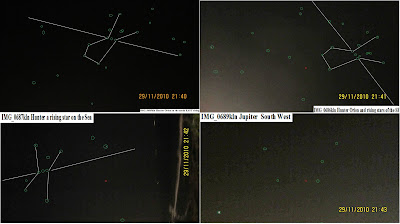The Astronomy Study and The weather Scenario of Visakhapatnam during 4th Week November 2010 PART B:
by
Professor Dr. Kotcherlakota Lakshmi Narayana
{Retd.Prof.of Physics, SU} 17-11-10, Narasimha Ashram, Official Colony, Maharanipeta.P.O. Visakhapatnam-530002. Cell: 9491902867 BSNL
ABSTRACT:
It rained in the night of 22nd November 2010 during the wee hours of 23rd November 2010 with the clouds silently gathered with the Moon rise on the eve of 22nd. The previous study showed the development of the rain clouds with the formation of a haze since the 18th November 2010 following the Full Moon day of 21st November 2010. The moon was near the stars of Zeta of Pisces, passed through Aries and it rained when it was located near the Eta of Taurus. Moon near Aldebaran (Rohini) and Lambda of Orion (Mrigasira) has not rained but the sky remained cloudy with the Moon predominant Air-Glows. The ancient findings of eons have changed by considerable astronomical positions and a further analysis is a dire need. What is noteworthy is that the Moon has crossed the Orion Hunter on the 24th November 2010 night and 25th Nov 2010 morning it is away from the Hunter Betelgeuse (ARDHRA?) star! Moreover the Moon had the splendid background shine of the Milky Way that can be easily noticed even with naked eye. Elsewhere the presence of cloud masses were found not obstructive to observe clearly the background Milky Way (Akasha Ganga) shine of fine structure and somewhat uniformly distributed around it for a considerable distance. The Arudhra identification in present day Astronomy Data is ambiguous in the Indian Ancient calendar. The early morning images captured, by the present author, of the Moon is breath taking in view of their splendid display of the terrestrial shadows with mountain cliffs.
Please refer PART A for the earlier images Fig Nos.1 to 17
IMAGES:
Fig Nos: 18 to 31

Fig 18 IMG_0656kln Jupiter on the Beach

Fig 19 IMG_0660kln Moon Denebola Regulus

Fig 20 IMG_0661kln Moon near stars Capella Auriga distant

Fig 21 IMG_0663kln Moon near Star

Fig 22 IMG_0668kln Moon in Leo

Fig 23 IMG_0674kln Moon near stars

Fig 24 IMG_0681kln Moon with several visible stars

Fig 25 IMG_0685kln hunter Orion ON THE south EAST rising

Fig 26 IMG_0691kln North East Stars Capella Auriga Castor Pollux

Fig 27 IMG_0699kln The Moon Air Glow extraordinary at 4h21m30th Nov2010

Fig 28 IMG_0708kln Moon with terrestrial shadow amazing with three cliffs05h18m30Nov
2010

Fig 29 IMG_0719kln Moon in a different Capture at5h27m30Nov2010

Fig 30 moonspectrum25112010at22h09mprofile

Fig 31 moonspectrum2511201022h09mprofile
Results:
The Indian Calendar has identified several stars of prominence and brightness eons ago and especially they said that the Head of the Hunter was a three straight line stars, called Invaka. The two bright stars identified by them as Jeystha and Ardhura seem to be very correct but the Arudhra identification in present day Astronomy Data is ambiguous. The early morning images of the Moon are breath taking in view of their splendid display of the terrestrial shadows with mountain cliffs.
ACKNOWLEDGMENT:
I am indebted to late Prof.K.Rangadhama Rao D.Sc. (Madras) D.Sc. (London) for initiating me to do research studies and for his constant guidance during my professional career.
No comments:
Post a Comment